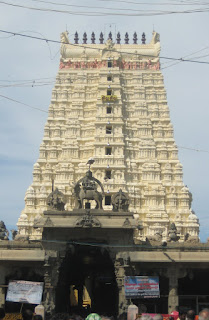13th November 2009, I along with my friends Vijay and Sundar started for a 2 days trip to explore the Central Tamilnadu. Based on our input and interest, Sundar prepared an excellent itinerary for the trip. We board the night train from Chennai egmore and reached Trichy in the early morning of 14th November 2009. Trichy is the hometown of Sundar and hence we had our lodging and breakfast at Sundar’s home (exactly at Lalgudi). Thanks a lot for Sundar’s mom for the great hospitality provided by her. After refreshing ourselves at Sundar’s home, we started for the trip in the Cab.
TRICHY:
We started our trip by making a visit to the Mariyamman Temple at Samayapuram. Though, it isn’t really a big temple, but it’s considered to be a famous pilgrimage center in Tamil Nadu. After Samayapuram, we headed for the Srirangam temple.
At around 8.30AM in the morning, we reached the Sri Ranganathaswamy Temple aka Srirangam temple. The whereabouts of the builder of this very old Vishnu temple is not known. I was surprised to know the fact that, Srirangam is the India’s largest temple with such a large landscape. It took somewhere around 45 mins to roughly explore the temple and I had no idea on way in and out, as it was so huge. As I saw in Chidambaram, this temple also has a Hall of 1000 pillars (Aayiram Kaal Mandapam) and a tank. It had around 21 Gopurams in almost all direction. The specialty of this temple is the darshan of the god through the Sorga Vaasal (Heaven door), which gets opened only during the month of December. For a nominal charge of Rs. 10/-, we are allowed to go to the roof of this temple to have an excellent top view of all the Gopurams. We spend around 1.5 hrs in the temple and started for the next item in the itinery. Since, we had already seen the Rock Fort Ganesh Temple, we decided to skip it and move on to the Tanjore.
It took somewhere around 2 hrs from Srirangam to reach the Tanjavur Big Temple. Tanjore Big Temple aka Brihadeeswarar temple was built by the great Rajaraja cholan. This temple has two short wide grant Gopurams and on entering which, you can see the finest Dravidian architecture. The attractive parts of this temple are
1. The rocks used to built this temple gives a tone of reddish color which is very beautiful
2. The Height of the main temple is the tallest that I have ever seen for any temple.
3. The temple is surrounded by fortified walls, beyond which the shadow of the main temple will never cast
4. A big huge Nandi (holy bull) in front of the main temple.

I was so mesmerized with the beauty of this temple, that we spend around 1.5 hrs in this place. I tried my level best to take a good snap of the place, but in vain couldn’t get one. Later, I realized that neither mine nor any other camera is good enough to capture such a beautiful thing and a personal visit is always required to enjoy such a majestic beauty. By the time we took all our photos and tried to go for the darshan, it was 1PM and hence the darshan was closed. It was a lesson to me, that all temples in Tamil Nadu will be closed between 1 and 4 PM and hence plans accordingly. It was unfortunate that we couldn’t have darshan of the Shiva Lingam. At this point of time, I can say for sure that Tanjore Big temple is the Must See and the Best of Tamilnadu. After lunch at the Tanjore( the rice bowl of tamilnadu), we started to Airavateswarar temple at Darasuram.
DARASURAM:
Airavateswarar Temple is located at Darasuram, near Kumbakonam. It was a 1.5 hours of journey to reach this place. This temple is just a miniature version of the Brihadeswarar temple. This is yet another Siva temple built by the Rajaraja chola II. Currently, there are some renovation works going on this temple. This temple is recently added to the list of the UNESCO World Heritage site. After Airateswarar temple, we started to Gangaikonda Cholapuram.
GANGAIKONDA CHOLAPURAM:
It took somewhere around 1 hr to reach the GangaiKonda Cholapuram temple. This is yet another replica of the Brihadeswarar temple. No wonder, why this temple has similar architecture style?, as this temple is build by the son of Rajaraja chola “Rajendra chola”. This place was named as GangaiKonda Cholapuram marking his victory over the northern regions. Cholas are great devotees of Shiva and this temple is yet another example for it. This Siva temple has a large Nandi, even bigger than the Brihadeswarar temple Nandi. Though, this temple doesn’t have any gopuram, still it has some wells around it. After some photo shoot, we started back to Trichy for Visiting the Kalannai Dam.
But unfortunately, the rain started coming heavily and hence we planned to skip Kalannai dam. At around 8PM, we return back to Sundar’s home for rejuvenating ourselves. That’s the end of the Day1 of my 2days Central Tamilnadu trip; catch you all with yet another interesting blog on Day2 actions.
Please check out the following links for more photos.
http://picasaweb.google.co.in/parthi007/TrichySrirangam#
http://picasaweb.google.co.in/parthi007/Tanjore#
http://picasaweb.google.co.in/parthi007/GangaikondacholapuramAndDarasuram#

















